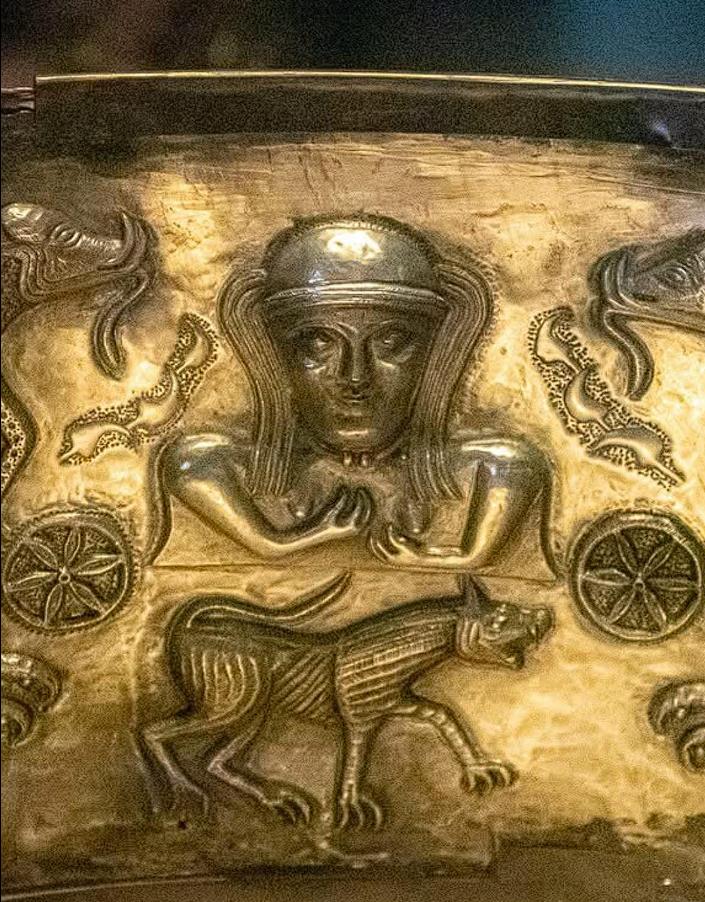“From the depths of a Danish peat bog, shrouded in the darkness of centuries, emerged the Gundestrup Cauldron, a relic of Iron Age Europe that continues to astound. This extraordinary silver vessel, weighing nearly 9 kilograms and forged between 150 and 1 BC, offers a profound glimpse into the spiritual realm of the ancient Celts, a world where myth and ritual intertwined.”

A Divine Assembly: Glimpses into a Lost Pantheon
- The Goddess’s Gaze: A Vision in Silver and Shadow:
- Discovered in 1891, the cauldron’s interior plates revealed a captivating figure: a goddess, her presence commanding attention amidst a tapestry of ornate details. Extensive gilding and inlaid glass eyes, now dimmed by time, once gleamed in the flickering light of ancient ceremonies.
- This depiction was not merely an artistic flourish; it was a window into the Celtic reverence for the divine feminine, a testament to the power they attributed to their goddesses. Her image, meticulously crafted, spoke of a world where spirituality was woven into the fabric of daily existence.
- She formed but one part of a wider divine cast, a pantheon of gods and goddesses who presided over the fundamental aspects of life: fertility, beauty, wisdom, life, and death. Their presence, etched in silver, spoke of a complex belief system that shaped the Celtic understanding of the cosmos.
- A Tapestry of Myth: Engraved Narratives in Silver:
- The cauldron, in its entirety, comprises five inner and seven outer plates (with one outer plate now lost), each surface meticulously engraved with elaborate scenes. These depictions, though distinctly Celtic in their iconography—featuring horned deities, ritualistic scenes, and sacred animals—revealed a complex cultural narrative.
- These engravings were not mere decorations; they were visual narratives, silent stories of Celtic myth and ritual. They served as a tangible record of a world where the supernatural was not distant but deeply intertwined with the natural. Each panel, each figure, held a story, a belief, a sacred tradition.
A Cultural Crossroads: Craftsmanship and Origins
- A Fusion of Styles: The Cauldron’s Dual Heritage:
- While the iconography spoke of Celtic deities and rituals, the craftsmanship itself told a different tale. The intricate silverwork and stylistic flourishes bore a striking resemblance to Thracian metalworking traditions.
- This stylistic blend was not a mere coincidence; it suggested the cauldron’s creation at a cultural crossroads, a region where Celtic and Thracian communities once coexisted. The intricate nature of the silver work, and the knowledge of the metal working skills needed, points to a very skilled group of artisans.
- The most likely location for this cultural fusion was the region of modern-day southwest Romania or northwest Bulgaria, where these cultures once met, their traditions mingling and merging.
- A Witness to a Lost World: Art as Devotion and Declaration:
- The Gundestrup Cauldron transcends its status as a masterpiece of ancient metallurgy. It stands as a silent witness to a world where myth and ritual shaped identity, where art served as both a form of devotion and a declaration of cultural identity.
- Through its panels, we hear the echoes of gods once worshiped, of beliefs once held sacred, their stories forever preserved in silver and shadow. The cauldron is not just an artifact; it is a portal to a lost world, a tangible connection to the spiritual lives of those who came before.
Conclusion
“The Gundestrup Cauldron, unearthed from the depths of a Danish peat bog, is a profound testament to the intricate spiritual world of the ancient Celts. It stands as a silent narrator, its silver panels whispering tales of gods, rituals, and a cultural fusion that shaped the very identity of a people. Through its intricate craftsmanship and potent iconography, the cauldron continues to resonate, a timeless echo of a world where myth and artistry were inseparable.”

CÁC TIN KHÁC
Mary Walton: The Forgotten Inventor Who Helped Clean Up America’s Cities
Tomb of Queen Nefertari in the Valley of the Queens, Egypt
Discover the Hypostyle Hall of the Temple of Hathor at Dendera
Venus de Losange: Unveiling the Mystery of a 20,000-Year-Old Paleolithic Icon